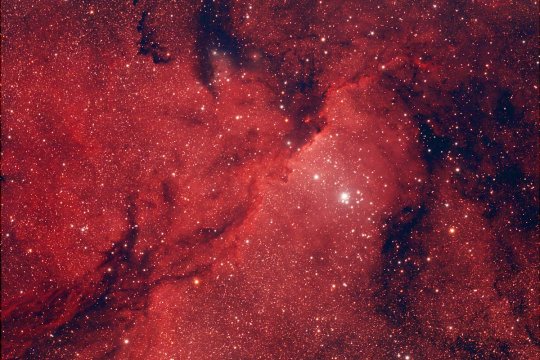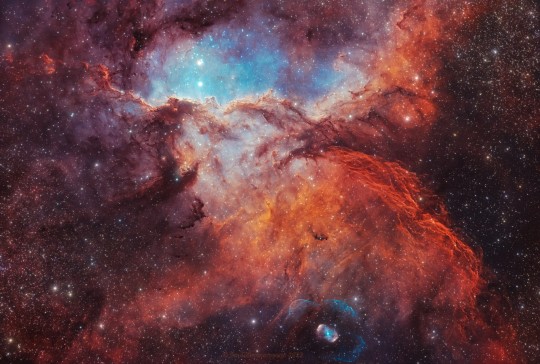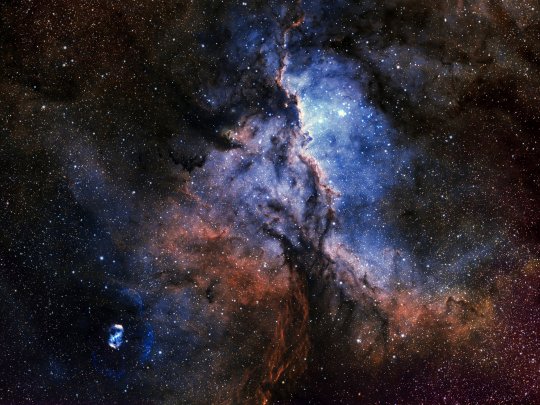#NGC 6188
Explore tagged Tumblr posts
Text

Fighting dragons of Ara © Aleix Roig
#space#stars#astrophotography#solar system#galaxy#planet#nebula#nasa#universe#cosmos#astronomy#night sky#ngc 6188
956 notes
·
View notes
Text

The Fighting Dragons of Ara (NGC 6188, center) guarding the Dragon's Egg Nebula (NGC 6165, lower right) // Bruno Rota Sargi
#astronomy#astrophotography#nebula#emission nebula#star-forming region#dragons of ara#fighting dragons of ara#dragon's egg nebula#NGC 6188#NGC 6164#NGC 6165#ara
140 notes
·
View notes
Text
A Southern Emission Nebula
An emission nebula and open star cluster in the constellation of Ara.
NGC 6188, Caldwell 82, in Ara With Associated Open Star Cluster NGC 6193 Image exposure:121 MinutesImage Size:1.54º x 1.03ºImage date:2023-06-10 Don’t just look at the nebula. Look at the stars too. A nebula is nothing without its stars and this emission nebula has some vivid star clusters and numerous bright strings of stars associated with it. The main star cluster NGC 6193, which is…

View On WordPress
#amateur astronomy#Ara#Astronomy#C82#Caldwell 82#Cosmic Focus Observatory#cosmos#deep sky#Featured#HD 150135#HD 150136#image#nature#Nebula#NGC 6188#NGC 6193#photography#rcw 108#science#Skywatcher EQ6-R#Skywatcher esprit 120#space#Universe#ZWO ASI071
7 notes
·
View notes
Text

NGC 6188, Fighting Dragons of Ara
980 notes
·
View notes
Photo

Reflections on NGC 6188
Credits: Robert Gendler, Martin Pugh
70 notes
·
View notes
Text

NGC 6188 aka the Firebird Nebula - an emission nebula in the constellation Ara, photographed 8th July 2023 using
Takahashi FSQ EDA (4.17") Siding Springs Observatory, Australia via iTelescope.net
141 notes
·
View notes
Photo

2024 June 19
NGC 6188: Dragons of Ara Image Credit & Copyright: Carlos Taylor
Explanation: Do dragons fight on the altar of the sky? Although it might appear that way, these dragons are illusions made of thin gas and dust. The emission nebula NGC 6188, home to the glowing clouds, is found about 4,000 light years away near the edge of a large molecular cloud, unseen at visible wavelengths, in the southern constellation Ara (the Altar). Massive, young stars of the embedded Ara OB1 association were formed in that region only a few million years ago, sculpting the dark shapes and powering the nebular glow with stellar winds and intense ultraviolet radiation. The recent star formation itself was likely triggered by winds and supernova explosions from previous generations of massive stars, that swept up and compressed the molecular gas. This impressively detailed image spans over 2 degrees (four full Moons), corresponding to over 150 light years at the estimated distance of NGC 6188.
∞ Source: apod.nasa.gov/apod/ap240619.html
104 notes
·
View notes
Text

Dragons fighting in space?
Just kidding. These "dragons" are made up of gas and dust in the emission nebula NGC 6188, which is 4000 lightyears away in the Ara constellation!
Image by: Carlos Taylor
35 notes
·
View notes
Text

NGC 6188, 6164-5 and Surroundings (HOS True Colorish)
#astronomy#astronomers#nasa#universe#nasa photos#astrophotography#outer space#astrophysics#nasawebb#hubble space telescope#nebula and quasar#dark nebula#nebulosa#planetary nebula#nebula#space exploration#space#science#space travel#international space station#space photography#nasa science#space science#james webb space telescope#science facts#planetary science#our universe#the universe#astronomy facts#nasa astronauts
29 notes
·
View notes
Text

NGC 6188, also known as the Fighting Dragons of Ara, easily the most badass name for an emission nebula that I have ever come across
56 notes
·
View notes
Text
NGC 6188: Ara’nın Ejderhaları
Günün Astronomi Görseli 19 Haziran 2024 Görsel & Telif: Carlos Taylor Ejderhalar gökyüzünün sunağında mı savaşır? Öyle görünse de, bu ejderhalar ince gaz ve tozdan oluşan illüzyonlar. Parlayan bulutlara ev sahipliği yapan emisyon bulutsusu NGC 6188, yaklaşık 4000 ışık yılı uzaklıkta, güney takımyıldızı Ara’da (Sunak) görünür dalga boylarında görülmeyen büyük bir moleküler bulutun kenarında…

View On WordPress
2 notes
·
View notes
Text

The Fighting Dragons of Ara (NGC 6188, center), the Dragon's Egg Nebula (NGC 6164/6165, lower right), and NGC 6193 (C82, center) // Regina Wille-Fier
In this larger image is the open cluster NGC 6193 that was part of the Caldwell Catalog. Surrounding it are two nebulae: the Fighting Dragons of Ara (NGC 6188) who are "fighting" over the Dragon's Egg Nebula (NGC 6164/6165). The open cluster was discovered by James Dunlop (1793-1848) in 1826, but it is unlikely that he saw the surrounding nebulosity very well. The entire scene is best seen during the winter months in the southern hemisphere.
#astronomy#astrophotography#caldwell catalog#stars#star cluster#open cluster#NGC 6193#caldwell 82#C82#nebula#emission nebula#star-forming region#fighting dragons of ara#dragons of ara#dragon's egg nebula#NGC 6188#NGC 6164#NGC 6165#ara
61 notes
·
View notes
Text
The Rim Nebula
Geriatric activities: playing bingo or running an astronomy club?
A Nebula in Ara Bright Nebula NGC 6188 & Star Cluster NGC 6193, Caldwell 82 Image exposure: 120 minutesImage Size:Size: 2.08° x 1.39° Image date:2024-06-09 I imaged this object a year ago and decided to try it again by using a reducer to increase the field of view. The nebula, NGC 6188 is listed as only 20 arc-minutes across. It actually forms part of a much larger region known as the Ara…

View On WordPress
#amateur astronomy#Ara#Astronomy#Caldwell 82#Cosmic Focus Observatory#cosmos#deep sky#Featured#Galaxy#image#nature#NGC 6188#NGC 6193#photography#rcw 108#science#Skywatcher EQ6-R#Skywatcher esprit 120#space#Stars#Universe#weather#ZWO ASI071
1 note
·
View note
Photo

NGC 6188, Dragons of Ara
#Astronomy#NASA#Night#Sky#Stars#Space#Science#Universe#Cosmos#Cosmic#Solar System#Dragons#Ara#Nebula#Galaxy#Constellations#Constellation#Rainbow#Bright
2K notes
·
View notes
Photo

NGC 6188 and NGC 6164
Credits: Harel Borenand Tal Faibish
21 notes
·
View notes
Text
ESO telescope captures most detailed infrared map of Milky Way ever
The latest report from the European Southern Observatory (ESO): ESO telescope captures the most detailed infrared map ever of our Milky Way

This collage highlights a small selection of regions of the Milky Way imaged as part of the most detailed infrared map ever of our galaxy. Here we see, from left to right and top to bottom: NGC 3576, NGC 6357, Messier 17, NGC 6188, Messier 22 and NGC 3603. All of them are clouds of gas and dust where stars are forming, except Messier 22, which is a very dense group of old stars. The images were captured with ESO’s Visible and Infrared Survey Telescope for Astronomy (VISTA) and its infrared camera VIRCAM. The gigantic map to which these images belong contains 1.5 billion objects. The data were gathered over the course of 13 years as part of the VISTA Variables in the Vía Láctea (VVV) survey and its companion project, the VVV eXtended survey (VVVX). Astronomers have published a gigantic infrared map of the Milky Way containing more than 1.5 billion objects ― the most detailed one ever made. Using the European Southern Observatory’s VISTA telescope, the team monitored the central regions of our Galaxy over more than 13 years. At 500 terabytes of data, this is the largest observational project ever carried out with an ESO telescope. “We made so many discoveries, we have changed the view of our Galaxy forever,” says Dante Minniti, an astrophysicist at Universidad Andrés Bello in Chile who led the overall project. https://youtu.be/Yalty4aTvCw This record-breaking map comprises 200 000 images taken by ESO’s VISTA ― the Visible and Infrared Survey Telescope for Astronomy. Located at ESO’s Paranal Observatory in Chile, the telescope’s main purpose is to map large areas of the sky. The team used VISTA’s infrared camera VIRCAM, which can peer through the dust and gas that permeates our galaxy. It is therefore able to see the radiation from the Milky Way’s most hidden places, opening a unique window onto our galactic surroundings. This gigantic dataset covers an area of the sky equivalent to 8600 full moons, and contains about 10 times more objects than a previous map released by the same team back in 2012. It includes newborn stars, which are often embedded in dusty cocoons, and globular clusters –– dense groups of millions of the oldest stars in the Milky Way. Observing infrared light means VISTA can also spot very cold objects, which glow at these wavelengths, like brown dwarfs (‘failed’ stars that do not have sustained nuclear fusion) or free-floating planets that don’t orbit a star.

This image from ESO’s VISTA telescope captures a celestial landscape of vast, glowing clouds of gas and tendrils of dust surrounding hot young stars. This infrared view reveals the stellar nursery known as NGC 6357 in a new light. It was taken as part of the VISTA Variables in the Vía Láctea (VVV) survey, which is currently scanning the Milky Way in a bid to map our galaxy’s structure and explain how it formed. The observations began in 2010 and ended in the first half of 2023, spanning a total of 420 nights. By observing each patch of the sky many times, the team was able to not only determine the locations of these objects, but also track how they move and whether their brightness changes. They charted stars whose luminosity changes periodically that can be used as cosmic rulers for measuring distances . This has given us an accurate 3D view of the inner regions of the Milky Way, which were previously hidden by dust. The researchers also tracked hypervelocity stars — fast-moving stars catapulted from the central region of the Milky Way after a close encounter with the supermassive black hole lurking there. The new map contains data gathered as part of the VISTA Variables in the Vía Láctea (VVV) survey and its companion project, the VVV eXtended (VVVX) survey. “The project was a monumental effort, made possible because we were surrounded by a great team,” says Roberto Saito, an astrophysicist at the Universidade Federal de Santa Catarina in Brazil and lead author of the paper published today in Astronomy & Astrophysics on the completion of the project. The VVV and VVVX surveys have already led to more than 300 scientific articles. With the surveys now complete, the scientific exploration of the gathered data will continue for decades to come. Meanwhile, ESO’s Paranal Observatory is being prepared for the future: VISTA will be updated with its new instrument 4MOST and ESO's Very Large Telescope (VLT) will receive its MOONS instrument. Together, they will provide spectra of millions of the objects surveyed here, with countless discoveries to be expected. Notes The dataset is too large to release as a single image, but the processed data and objects catalogue can be accessed in the ESO Science Portal. One way to measure the distance to a star is by comparing how bright it appears as seen from Earth to how intrinsically bright it is; but the latter is often unknown. Certain types of stars change their brightness periodically, and there is a very strong connection between how quickly they do this and how intrinsically luminous they are. Measuring these fluctuations allows astronomers to work out how luminous these stars are, and therefore how far away they lie. Vía Láctea is the Latin name for the Milky Way. Links Research paper Photos of of the survey telescopes at Paranal, including VISTA For journalists: subscribe to receive our releases under embargo in your language: - For scientists: got a story? Pitch your research === Amazon Ads === Celestron - NexStar 130SLT Computerized Telescope - Compact and Portable - Newtonian Reflector Optical Design - SkyAlign Technology - Computerized Hand Control - 130mm Aperture === When the Heavens Went on Sale: The Misfits and Geniuses Racing to Put Space Within Reach Read the full article
0 notes